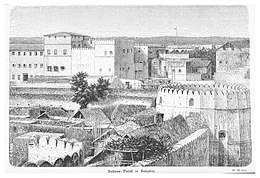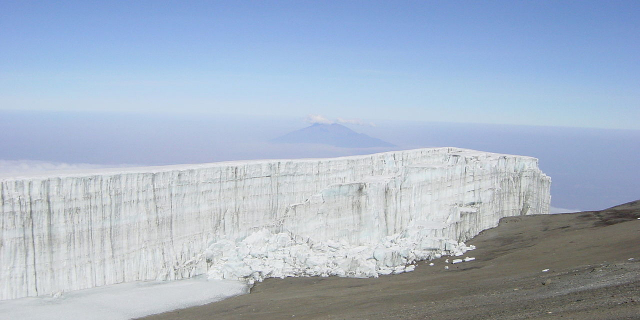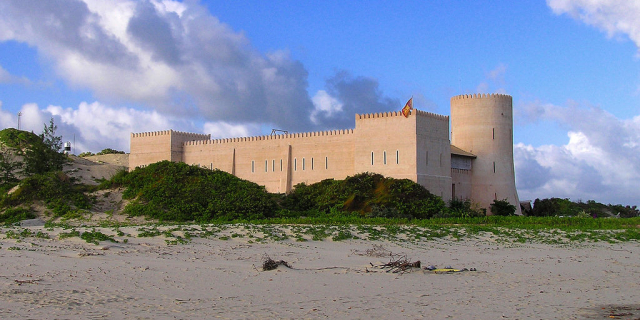Stone Town
Stone Town és el nom turístic, en anglès, pel que és coneguda la ciutat vella (literalment Mji Mkongwe en swahili, el nom local) de la ciutat de Zanzíbar, la principal ciutat de l'illa d'Unguja, a Tanzània. En oposició, la resta de la ciutat és anomenada Ng'ambo (en swahili a l'altre costat).
Sultanate of Kilwa before 1503![]() Portuguese Empire 1503–1698
Portuguese Empire 1503–1698![]() Sultanate of Oman 1698–1856
Sultanate of Oman 1698–1856![]() Sultanate of Zanzibar 1856–1890
Sultanate of Zanzibar 1856–1890![]() British Empire 1890–1963
British Empire 1890–1963![]() Republic of Zanzibar 1964
Republic of Zanzibar 1964![]() Tanzania 1964–present
Tanzania 1964–present
A Greco-Roman text between the 1st and 3rd centuries, the Periplus of the Erythraean Sea, mentioned the island of Menuthias (Ancient Greek: Μενουθιάς), which is probably Unguja.[1] Zanzibar, like the nearby coast, was settled by Bantu-speakers at the outset of the first millennium. Archaeological finds at Fukuchani, on the north-west coast of Zanzibar, indicate a settled agricultural and fishing community from the 6th century CE at the latest. The considerable amount of daub found indicates timber buildings, and shell beads, bead grinders, and iron slag have been found at the site. There is evidence for limited engagement in long-distance trade: a small amount of imported pottery has been found, less than 1% of total pottery finds, mostly from the Gulf and dated to the 5th to 8th century. The similarity to contemporary sites such as Mkokotoni and Dar es Salaam indicate a unified group of communities that developed into the first center of coastal maritime culture. The coastal towns, including those on Zanzibar, appear to have been engaged in Indian Ocean trade at this early period. Trade rapidly increased in importance and quantity beginning in the mid-8th century and by the close of the 10th century Zanzibar was one of the central Swahili trading towns.[2]
Shangani, the original fishing town that developed into Stone Town, was a small, largely unimportant Swahili site founded in the 11th century. Bigger towns at Unguja Ukuu, Kizimkazi, and Tumbatu were the island's powers from the 8th to the 16th century. The Portuguese built a church at Shangani in the early 16th century, and the Queen of northern Unguja had a house built there in the mid-17th century. When the Portuguese were ousted by Zanzibaris and Pembans in the 17th century, local patricians invited the Sultan of Oman to wield political power in exchange for defense against Portuguese reprisals. Part of the Portuguese church was built into the Omani fort, which housed roughly fifty soldiers. The Sultan also appointed a local governor, but political authority was still largely vested in the Mwinyi Mkuu, at this time Queen Fatima.[3]
Excavations at nearby Pemba Island, but especially at Shanga in the Lamu Archipelago, provide the clearest picture of architectural development. Houses were originally built with timber (c. 1050) and later in mud with coral walls (c. 1150). The houses were continually rebuilt with more permanent materials. By the 13th century, houses were built with stone, and bonded with mud, and the 14th century saw the use of lime to bond stone. Only the wealthier patricians would have had stone and lime built houses, the strength of the materials allowing for flat roofs, while the majority of the population lived in single-story thatched houses similar to those from the 11th and 12th centuries. According to Tom Middleton and Mark Horton, the architectural style of these stone houses have no Arab or Persian elements, and should be viewed as an entirely indigenous development of local vernacular architecture. While much of Zanzibar Town's architecture was rebuilt during Omani rule, nearby sites elucidate the general development of Swahili, and Zanzibari, architecture before the 15th century.[4]
Omani Dominion
Stone Town is located along a natural harbour and the first Europeans to set foot on the island of Zanzibar were the Portuguese. The Portuguese ruled the island for over 2 centuries and began constructing Stone Town's first stone structure, the Old Fort.[5] However, towards the end of the 17th century the Sultanate of Oman took over the island and completed the fort to prevent future attacks. The first stone houses in Stone Town probably began to be built in the 1830s, gradually replacing an earlier fishing village around the Old Fort.[6] At the time the Sultanate of Oman controlled the Zanzibar Archipelago, Mombasa and the Swahili coast.
In 1840, Sultan Said bin Sultan moved his seat from Muscat, Oman, to Stone Town, which thus entered an era of quick development as the new capital of the Sultanate of Oman and Zanzibar. With the British outlawing the slave trade in the Indian Ocean, the Sultanate's fortunes crashed. The Muscat economy was in shambles and many Omanis migrated to Zanzibar. The increase in the Arab population on the island facilitated further growth and more buildings began to spring up in the town. Furthermore, grand royal structures like the House of Wonders and the Sultan's Palace were also built. In 1861, as a consequence of a war of succession within the Omani royal family, Zanzibar and Oman were separated, with Zanzibar becoming an independent sultanate under Sultan Majid bin Said.
In the 19th century Stone Town flourished as a trading centre. It was especially renowned for the commerce of spices (mostly cloves) and slaves. Around middle of the century, the sultanate had a close relationship with the British; David Livingstone, for example, is known to have stayed in Stone Town in 1866 while he was preparing his final expedition into the interior of East Africa.[7] In the same period, several immigrant communities from Oman, Persia and India formed as a consequence of the town's intense commercial activity. The Sultan of Zanzibar encouraged immigration of foreign traders who became very wealthy and settled in the city who brought diversity to the city's architecture.[8]
Colonial Control
In the last decades of the century, the Sultans of Zanzibar gradually lost their possessions in mainland East Africa to the German Empire and the United Kingdom. In 1890, with the Heligoland-Zanzibar Treaty, Zanzibar itself became a British protectorate.[9] In 1896, a sudden rebellion of the Zanzibari Omanis against the British rule led to the Anglo-Zanzibar War, which is remembered as the shortest war in history: the Sultan surrendered after 45 minutes of naval bombardment of Stone Town by the Royal Navy.[10]
During the period of British protection, the Sultan still retained some power and Stone Town remained a relatively important trading centre for the informal trade. Though the town previously had a small railway the British constructed a railway from the Town to Bububu village. The British did not fund major developments in the town and allowed the sultan to manage the islands affairs from stone town.[11] The British gave privileges to Mombasa and Dar es Salaam as their trading stations in East Africa.
Zanzibar Revolution
In 1964, Stone Town was the theatre of the Zanzibar Revolution, which brought about the removal of the sultan and the birth of a socialist government led by the Afro-Shirazi Party (ASP). More than 20,000 people were killed and refugees, especially Arabs and Indians, escaped the island as a consequence of the revolution.[12] The Arabs and Indians left behind everything they had and the ASP quickly occupied old homes and converted them into public buildings. In 1964, when Tanganyika and Zanzibar combined to form Tanzania, Stone Town kept its role as a capital and government seat for Zanzibar, which was declared a semi-autonomous part of the new nation.
![Cliff Kemper[2] - CC BY-SA 2.0](/sites/default/files/styles/640x320/public/2022-03/Serengeti_gazelles.jpeg?h=ead717b0&itok=JsZMti_M)































Afegeix un nou comentari